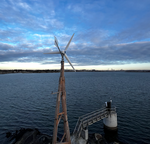01/09/2004
Energy to 2050: Scenarios for a Sustainable Future -
The bulk of man-made greenhouse gas emissions originate from energy use and production, explains ‘Energy to 2050: Scenarios for a Sustainable Future.’ The report is designed to provide analysis on climate change and to develop scenarios to show the impacts of alternative paths of action. “Stabilising carbon dioxide concentration levels will be a formidable challenge in a world with growing energy needs, but we think solutions exist and can be further developed,” says executive director Claude Mandil. “There is one thing of which we are certain, however: climate change mitigation will require profound changes in energy production and use worldwide.” Nuclear grew by an annual average rate of 11.5% from 1971 to 2000, while renewables (other than biomass) grew by 3.2. Biomass grew by 1.7% a year over those three decades, natural gas grew by 3%, coal increased 1.7% and oil consumption grew by 1.3% a year. Under IEA’s ‘SD Vision,’ nuclear will grow by an average of 5.4% a year from 2000 to 2050, reaching 8% annual growth rates during the 2020s, while renewables will grow by an average of 5.3% a year over the half century, topping out at 6% in the 2010s. These two sources of primary energy are well ahead of the 2.5% annual average growth for biomass and 2.4% for natural gas.
“Using energy more efficiently is the most obvious ‘win-win’ strategy that allows reduced emissions along with lower energy costs and lower energy investments,” the report concludes. IEA’s recently published ‘World Energy Investment Outlook’ shows that improvements in energy efficiency and greater production from renewables “significantly slow” the growth of CO2 emissions. “Energy technologies already exist that can substantially reduce emissions, but more will be needed,” and IEA says its implementing agreements on renewable energies, clean coal, CO2 sequestration, hydrogen, fusion and energy efficiency can help. The global agency pledged to extend its role with respect to climate change by linking the environmental, energy security and economic development issues that are equally essential to achieving sustainability. “Strategic planning and political decisions demand that we explore options for the future,” and the report introduces different scenarios to analyse specific interactions between energy and environment over the longer term to “stimulate new thinking in this critical domain.”
“Using energy more efficiently is the most obvious ‘win-win’ strategy that allows reduced emissions along with lower energy costs and lower energy investments,” the report concludes. IEA’s recently published ‘World Energy Investment Outlook’ shows that improvements in energy efficiency and greater production from renewables “significantly slow” the growth of CO2 emissions. “Energy technologies already exist that can substantially reduce emissions, but more will be needed,” and IEA says its implementing agreements on renewable energies, clean coal, CO2 sequestration, hydrogen, fusion and energy efficiency can help. The global agency pledged to extend its role with respect to climate change by linking the environmental, energy security and economic development issues that are equally essential to achieving sustainability. “Strategic planning and political decisions demand that we explore options for the future,” and the report introduces different scenarios to analyse specific interactions between energy and environment over the longer term to “stimulate new thinking in this critical domain.”
- Source:
- Online editorial www.windfair.net
- Author:
- Trevor Sievert, Online editorial journalist
- Email:
- press@windfair.net
- Keywords:
- Renewable energy






